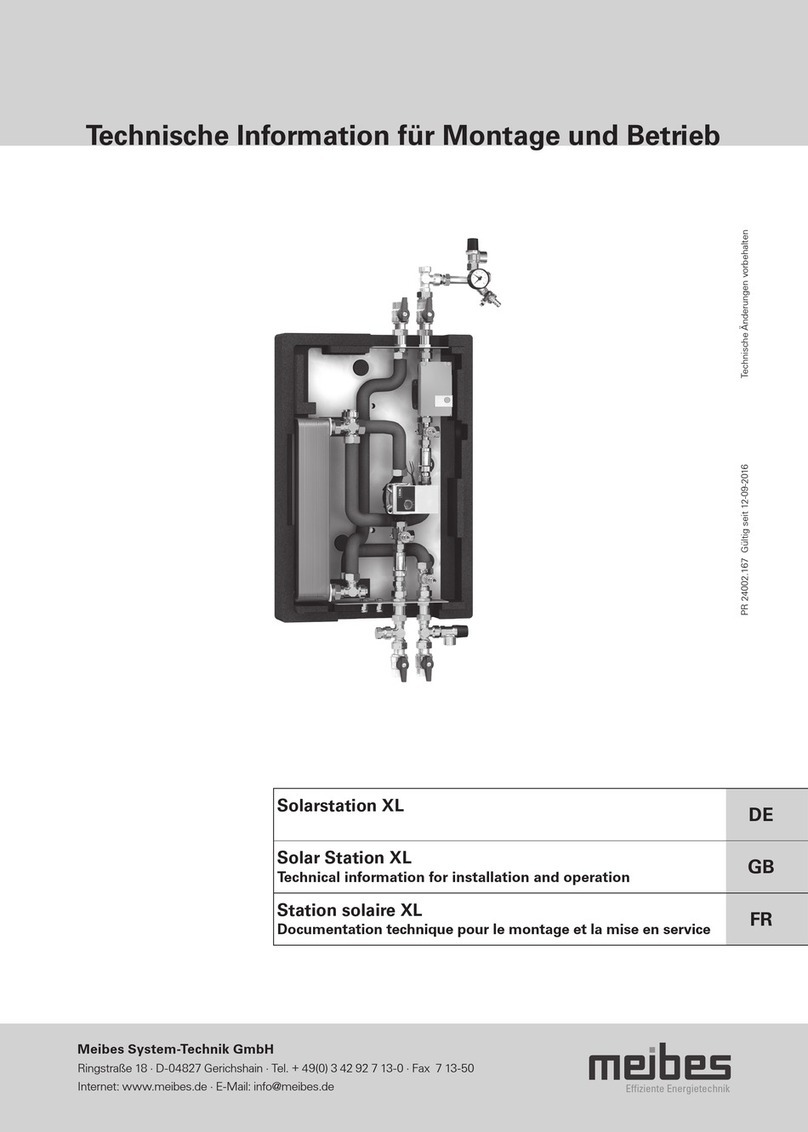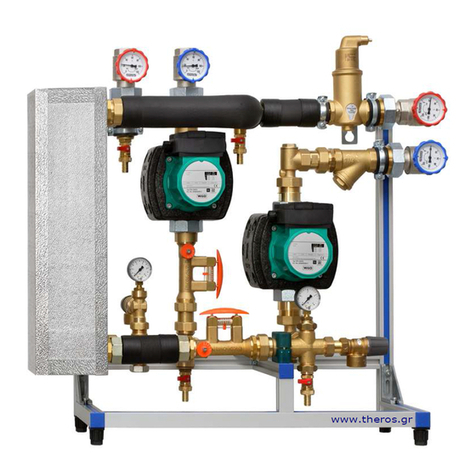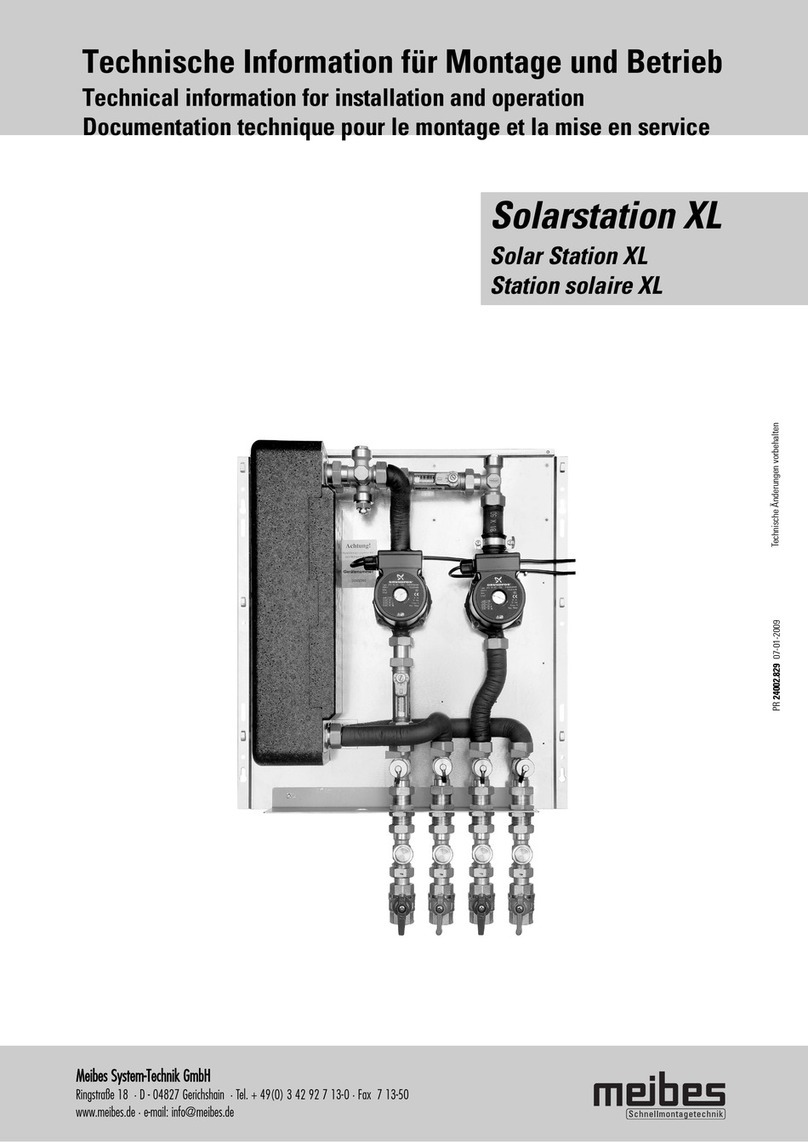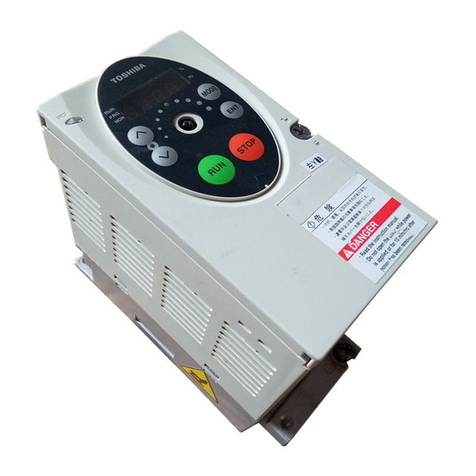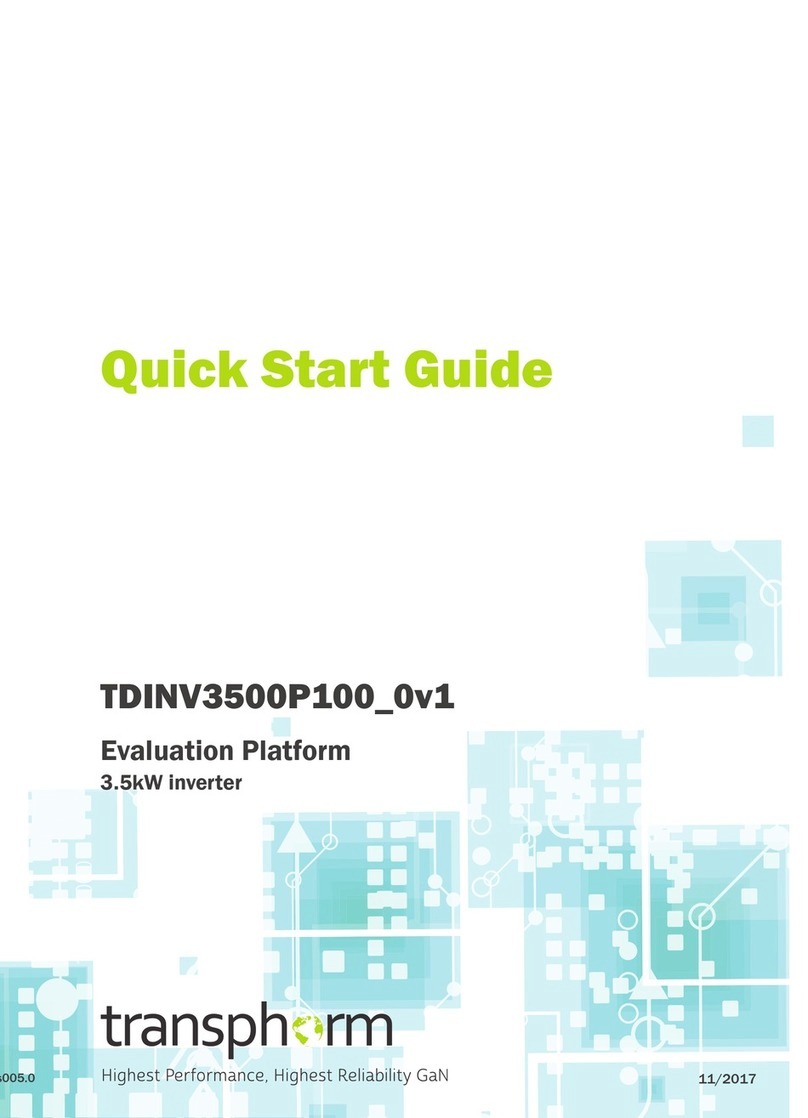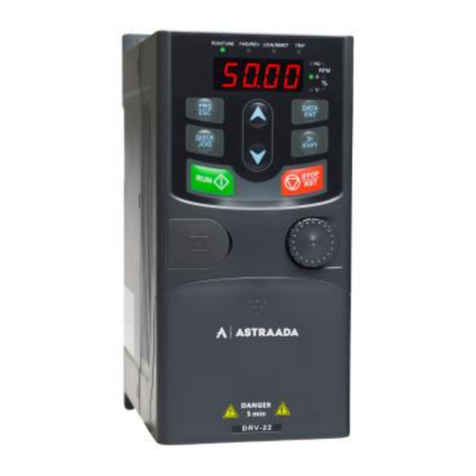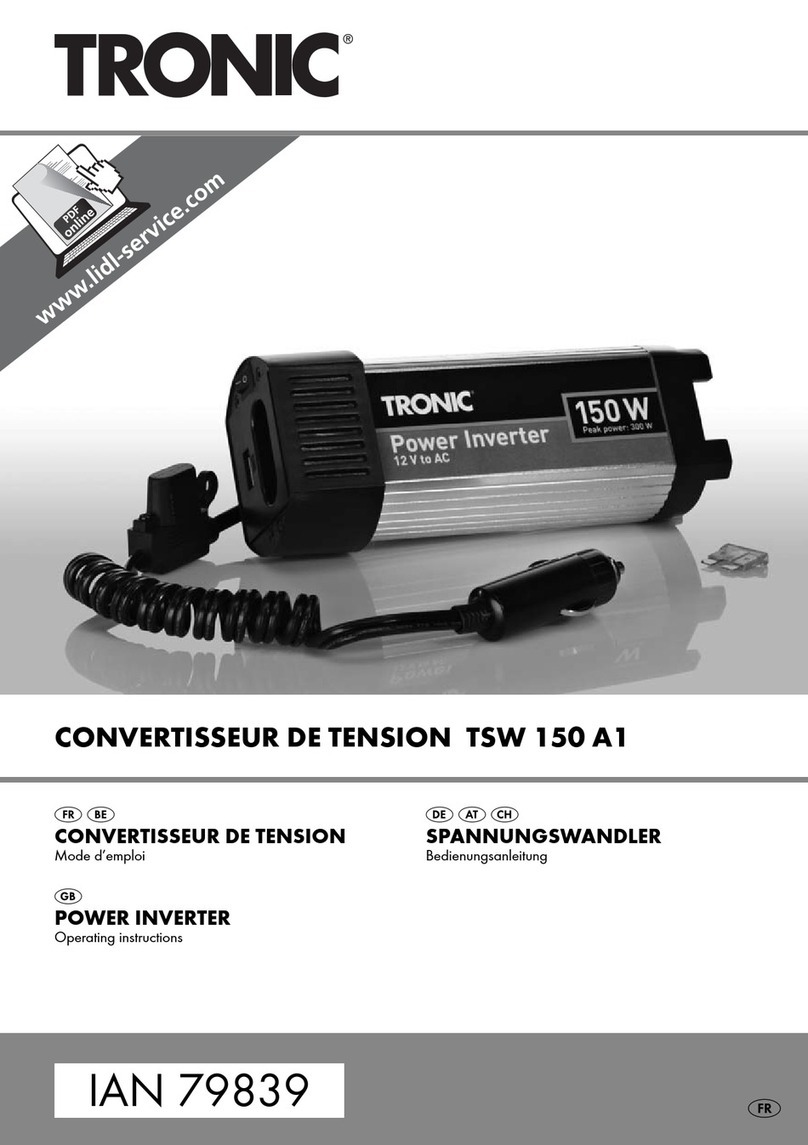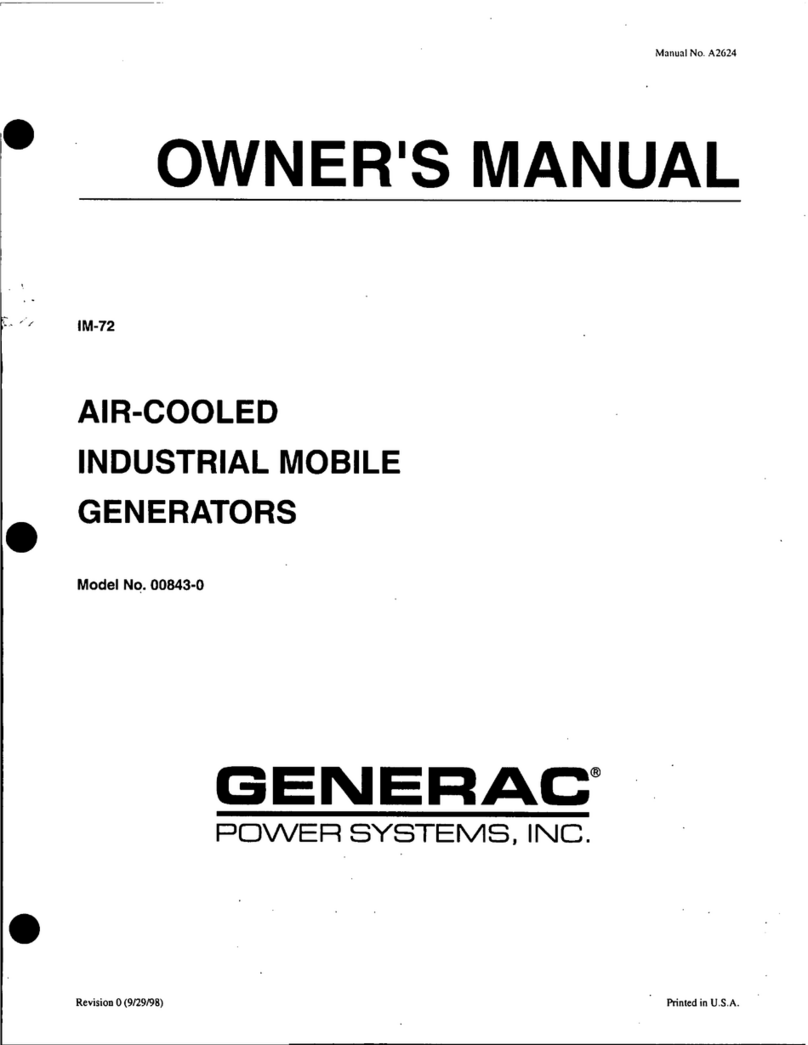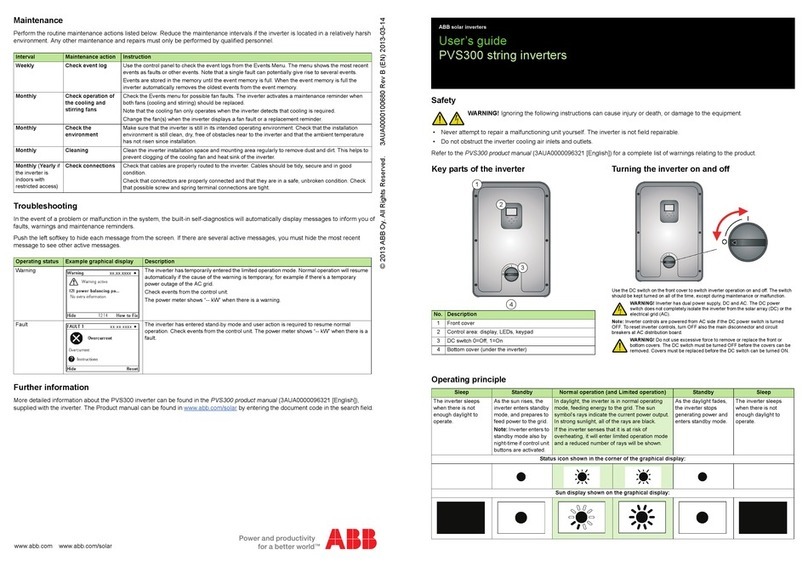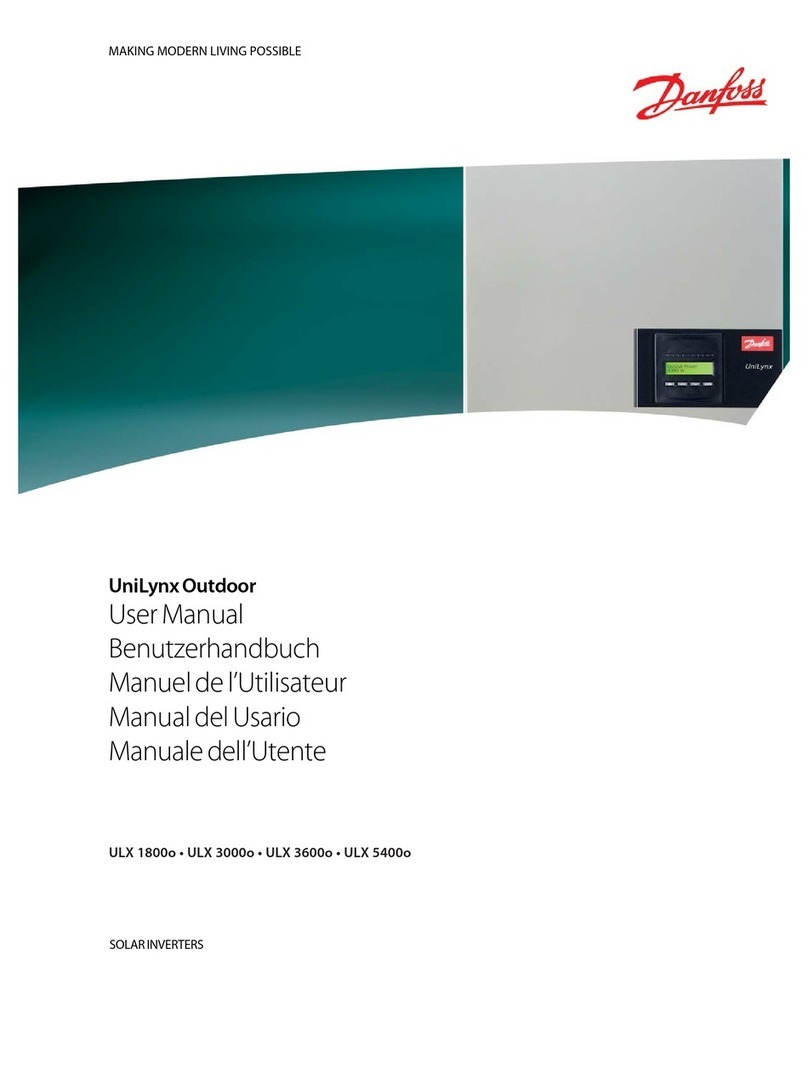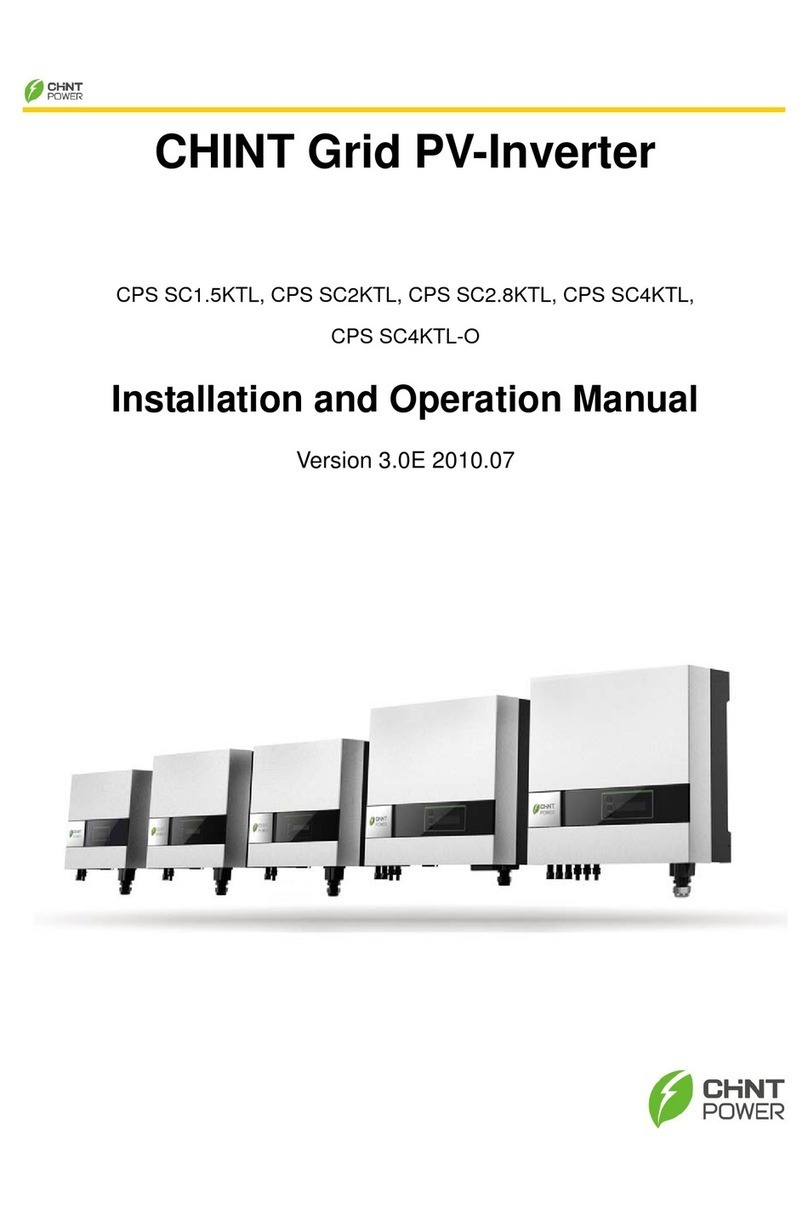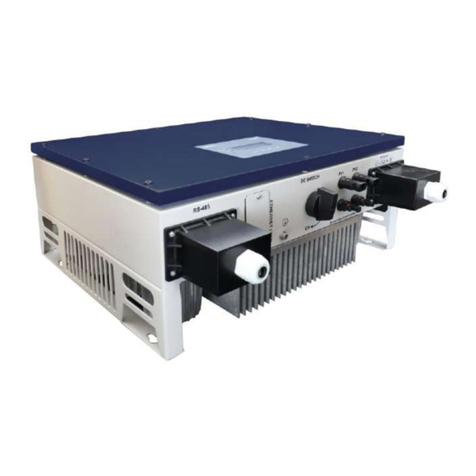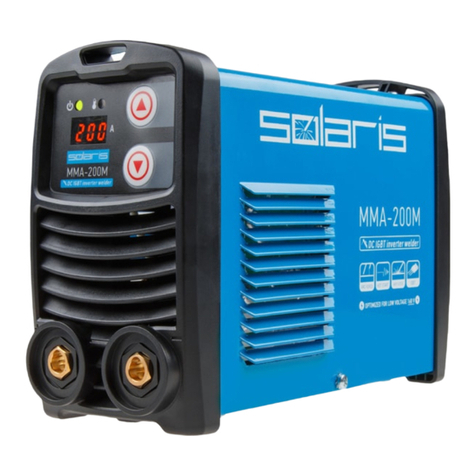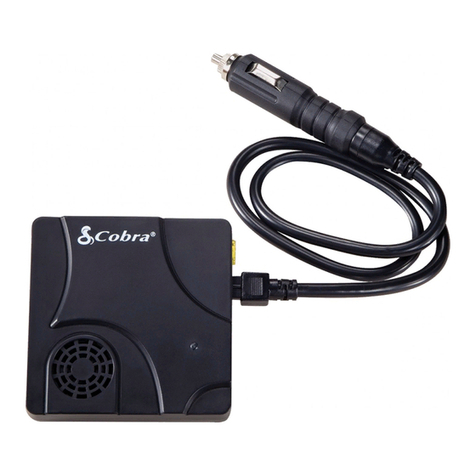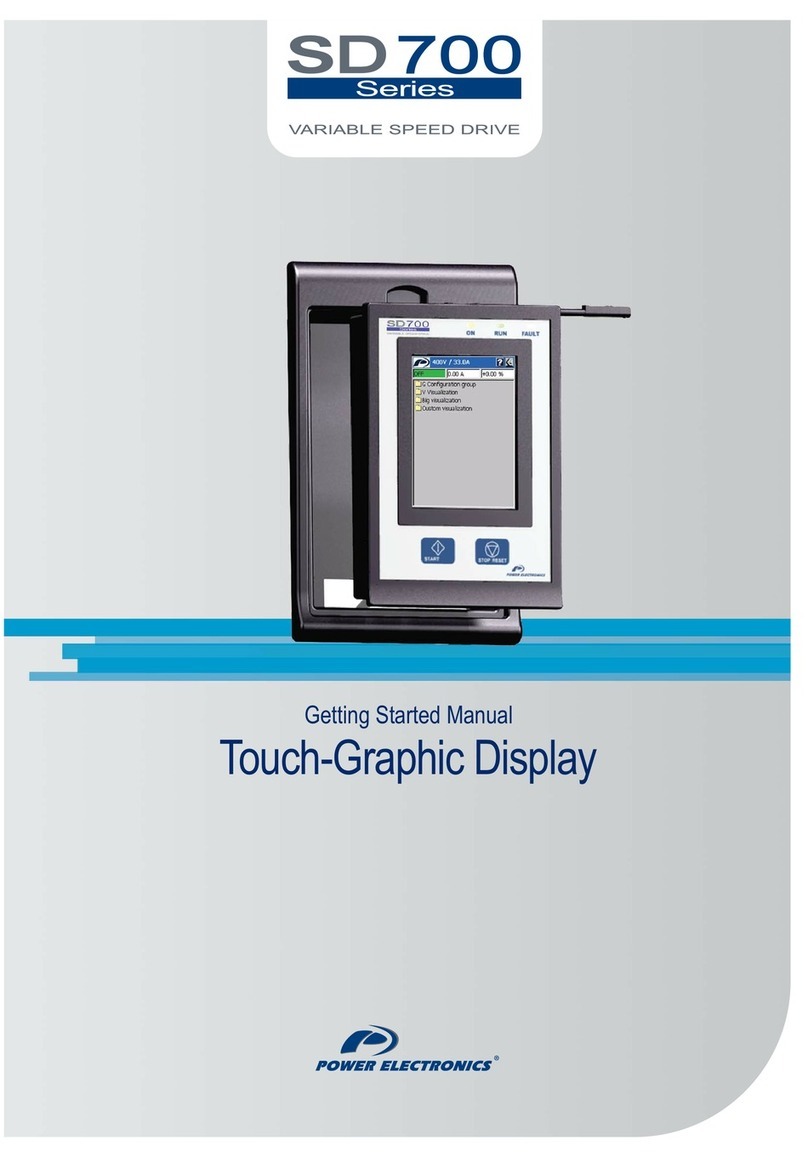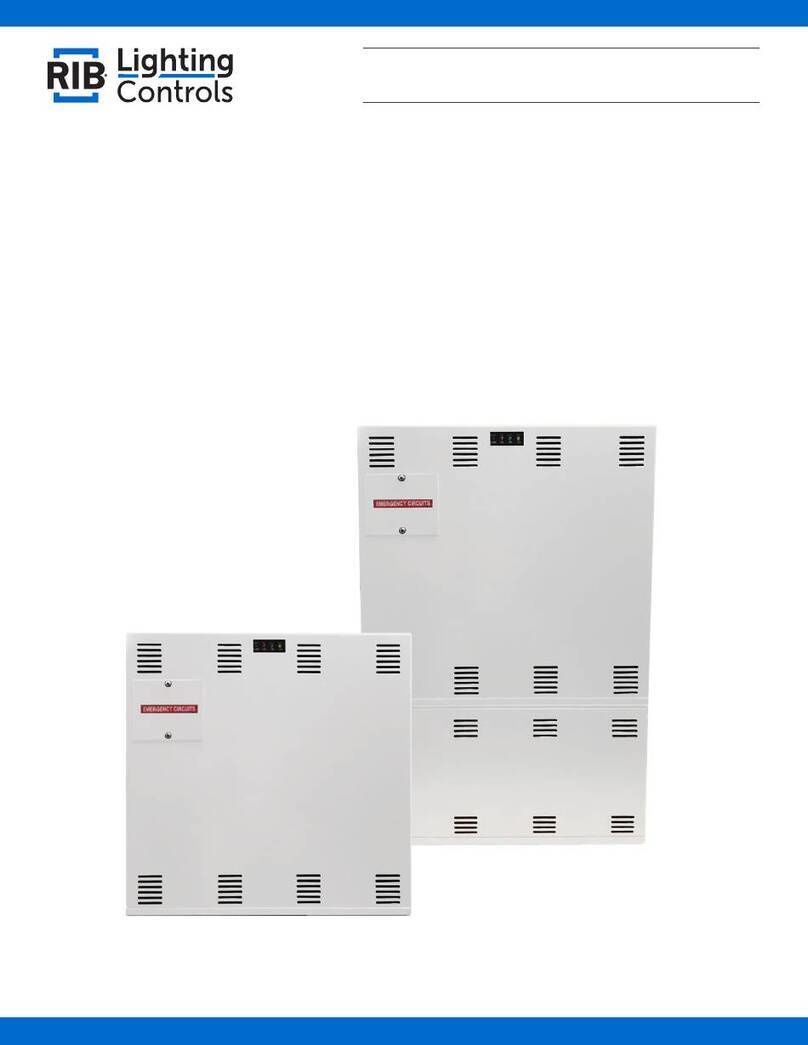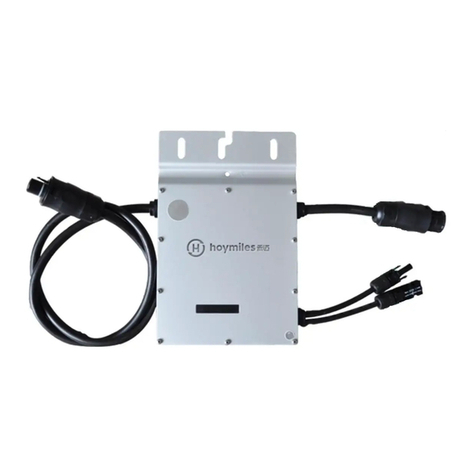meibes Solar station S Manual

Solarstation S
Technische Information für Montage und Betrieb DE
PR 24002.816 10-05-2016Technische Änderungen vorbehalten
Solar station S
Technical information for installation and operation GB
Station solaire S
Documentation technique pour le montage et la mise en service FR
Technische Information für Montage und Betrieb
.Effiziente Energietechnik
Meibes System-Technik GmbH
Ringstraße 18 · D-04827 Gerichshain · Tel. +49 (0) 3 42 92 7 13-0 · Fax 7 13-808
Internet: www.meibes.de · E-Mail: [email protected]

32
Lesen Sie vor der Montage diese Anleitung sorgfältig durch. Die Montage und Erstinbetriebnahme
der Komplettstation darf nur von einer zugelassenen Fachfirma ausgeführt werden. Machen Sie
sich vor Arbeitsbeginn mit allen Teilen und deren Handhabung vertraut.
Beachten Sie die gültigen Unfallverhütungsvorschriften, Umweltvorschriften und gesetzlichen Regeln für
die Montage, Installation und den Betrieb. Des Weiteren die einschlägigen Richtlinien der DIN, EN, DVGW,
VDI und VDE (inkl. Blitzschutz) sowie alle aktuellen relevanten länderspezifischen Normen, Gesetze und
Richtlinien.
Elektroanschluss:
Elektrische Anschlussarbeiten dürfen nur durch qualifiziertes Elektrofachpersonal ausgeführt werden.
Die VDE-Richtlinien und die Vorgaben des zuständigen EVU sind einzuhalten.
Auszug:
Thermische Solaranlagen und ihre Bauteile:
DIN EN 12975 Sonnenkollektoren
DIN EN 12976 Vorgefertigte Anlagen
DIN EN 12977 Kundenspezifisch gefertigte Anlagen
Elektrischer Anschluss:
VDE 0100 Errichtung elektrischer Betriebsmittel, Erdung, Schutzleiter, Potential ausgleichsleiter
VDE 0701 Instandsetzung, Änderung und Prüfung elektrischer Geräte
VDE 0185 Allgemeines für das Errichten von Blitzschutzanlagen
VDE 0190 Hauptpotentialausgleich von elektrischen Anlagen
VDE 0855 Installation von Antennenanlagen (ist sinngemäß anzuwenden)
Zusätzliche Hinweise:
VDI 6002 AllgemeineGrundlagen, Systemtechnik und Anwendung im Wonungsbau
VDI 6002 Anwendungen in Studentenwohnheimen, Seniorenheimen, Kranken-
häusern, Hallenbädern und auf Campingplätzen
1 Sicherheitshinweise
1.1 Vorschriften/Richtlinien 3
1.2 Bestimmungsgemäße
Verwendung 4
1.3 Erstinbetriebnahme 4
1.4 Arbeiten an der Anlage 4
1.5 Haftung 4
2 Technische Daten 5
3 Montage 7
3.1 Wandmontage 7
3.2 Absperrarmaturen 9
3.3 Thermometerwechsel 9
3.4 Sicherheitsventil 9
3.5 Rückflussverhinderer 10
3.6 Anschluss eines
Ausdehnungsgefäßes (bauseits) 10
3.7 10
4
4.1
4.2 11
4.3 11
4.4
5
Wärmeträgermedium
Druckprobe, Befüllen und
Spülen der Anlage
Druckprobe
Spülen und Befüllen
Entlüften
Entleeren
Ausführung 12-13
Solarkreisregelung
Bitte beachten:
Die Montage- und Betriebsanleitung
der Reglertyps liegt separat bei.
-Vor Gebrauch Montageanleitung lesen
- Schnittgefahr
- Quetschgefahr
1.1 Vorschriften/Richtlinien
DE
- Gefahr erhöhter Temperatur
- Sturzgefahr bei der Montage
- Gefahr elektrischer Spannung
Inhalt 1. Sicherheitshinweise
11
11
11

54
Die beschriebenen Stationen sind nur mit geeigneter bzw. zugelassener Solarflüssigkeit zu betreiben.
Es ist auf einen ausreichenden Frostschutzgehalt zu achten.
Die Verwendung eines anderen Mediums ist nicht zulässig.
Medientemperatur > 60 °C (Verbrühungsgefahr)
Soll- bzw. Befülldruck < Ansprechdruck der Sicherheitsarmatur
Alle Absperrarmaturen dürfen nur im Servicefall und bei abgedeckten Kollektoren geschlossen werden, da anson-
sten die Sicherheitsarmaturen ihre Wirkung verlieren.
Vorsicht:
Nehmen Sie keine Veränderungen an den elektrischen Bauteilen, der Konstruktion oder den hydraulischen
Komponenten vor! Sie beeinträchtigen sonst die sichere Funktion der Anlage.
Vor der Erstinbetriebnahme ist die Anlage auf Dichtheit, eine korrekte hydraulische Anbindung sowie sorgfältige
und korrekte elektrische Anschlüsse zu prüfen. Des weiteren ist ein sorgfältiges bzw. bedarfsgerechtes Spülen
gemäß DIN 4753 der Anlage durchzuführen. Die Erstinbetriebnahme hat durch eine geschulte Fachkraft zu erfol-
gen und ist schriftlich zu protokollieren. Darüber hinaus sind die Einstellwerte schriftlich festzuhalten. Die tech-
nische Dokumentation hat am Gerät zu verbleiben.
Die Anlage ist spannungsfrei zu schalten und auf Spannungsfreiheit zu kontrollieren (z.B. an der separaten Siche-
rung oder einem Hauptschalter). Anlage gegen Wiedereinschalten sichern. Die Kollektoren sind abzudecken,
um das System abzukühlen.
ACHTUNG! Verbrühungsgefahr! Medientemperatur > 60°C
Für diese Unterlage behalten wir uns alle Urheberrechte vor. Missbräuchliche Verwendung, insbesondere
Vervielfältigung und Weitergabe an Dritte ist nicht gestattet. Diese Montage- und Bedienungsanleitung ist dem
Kunden zu übergeben. Das ausführende bzw. zugelassene Gewerke (z.B.Installateur) hat dem Kunden die
Wirkungsweise und Bedienung des Gerätes verständlich zu erklären.
1.2 Bestimmungsgemäße Verwendung
1.3 Erstinbetriebnahme
1.4 Arbeiten an der Anlage
1.5 Haftung
Anschlüsse Solarkreis 3/4“ IG
für Ausdehnungsgefäß: 3/4“ AG
max. zul. Temperatur
max. zul. Druck
Rückflußverhinderer
Volumenstromanzeiger
Thermometer
Manometer
Sicherheitsventil
: +120 °C, kurzzeitig + 140 °C (max. zul. Temp. der Pumpe beachten!)
10 bar (Ansprechdruck Sicherheitsventil beachten!)
: 1-Strang: 1 x 300 mmWs 1 x 300 mm de ca
: 2-Strang: 2 x 300 mmWs
: Kombiskala: Propylenglykol 40 % : 0,8 ... 10,3 l/min Wasser : 1 ... 13 l/min
Anstelle des Volumenstromanzeigers kann auch eine Meßkapsel zur Leistungs- bzw.
Ertragserfassung montiert werden (bauseits anzupassen).
: Anzeigebereich 20 ... 150°C
: Anzeigebereich 0 ... 10 bar
: Ansprechdruck 6 bar
Abmessungen : Achsabstand : 100 mm
Höhe Isolation : 385 mm (1-Strang mit Regelung: 430 mm)
Breite gesamt : 300 mm (1-Strang: 200 mm)
Tiefe Isolation : 185 mm
DE
Die Solarstation S wird als 1- oder 2- Strangausführung
vormontiert mit oder ohne Hoch-Effizienz-Pumpe
geliefert. Optional erhältlich mit Solarregler sowie
Permanententlüfter.
Für den Einsatz in thermischen Solaranlagen bis ca. 12
m2Kollektorfläche. (In Abhängigkeit von Typ und
vorherrschenden / bestehenden Anlagenparametern)
1 Sicherheitsventil in Sicherheitsgruppe integriert
2 Manometer
3 KFE- Hahn mit Kappe und Schlauchtülle
4 Solarumwälzpumpe
5 Kleinverteiler mit Anschluß 3/4“AG für ein
Ausdehnungsgefäß (VDI 6002 Blatt 1)
Volumenregelorgan und KFE- Hahn
6 Volumenstromanzeiger
7 Absperrkugelhähne 3/4“ IG x 1“ IG-Überwurfmutter
mit integriertem Rückflußverhinderer
(handaufstellbar)
8 Thermometer
9 Permanententlüfter mit Hand-Schnell-Entlüfter
10 Blockisolation
(Bei 1-Strang-Solarstation nur ein Kugelhahn sowie ein
Thermometer. Pos. 9 entfällt.)
1. Sicherheitshinweise 2. Technische Daten

76
Die Montage hat an einer tragfähigen und
trocknen Wand zu erfolgen. Der Abstand zu
den Kollektoren ist so zu wählen, dass eine
Überhitzung der Station und des Ausdehnungsgefäßes
ausgeschlossen wird (gegebenenfalls Vorschaltgefäß einsetzen).
Gefährdungen durch angrenzende Bauwerkskomponenten,
Elektro-, Gas-, Wasser- oder Heizungsrohren sind zu vermeiden.
Der freie Zugang zur Station, Sicherheitsarmaturen und
den Anschlussleitungen ist sicherzustellen
Vor Modulmontage der Einstrang Solarstation die Isolierung
entfernen und das Modul aus Halterungsclip heben.
Das untere Befestigungsloch (hinter dem Durchflussmesser)
ist nach dem Entfernen des Moduls zugänglich.
Nach erfolgter Montage der Isolierung muss das Modul
zurück in den Halterungsclip. Überprüfen Sie die Festigkeit.
Hinweis:
Absperrarmaturen müssen stets geöffnet und gegen
unbeabsichtigtes Schließen gesichert sein.
Die Betätigung ist nur von geschulten Fachpersonal vorzunehmen!
Für den Betrieb der Anlage müssen die Kugelhähne komplett
geöffnet sein (Kapitel 3, erste Abb.).
Obere Absperrarmaturen
Die oberen Absperrarmaturen sind mit integrierten,
handaufstellbaren Rückflussverhinderer ausgerüstet.
Die Fließrichtung bzw. Stellung ist durch die angefaste
Seite ersichtlich (vgl. Abb.).
Bei Nichtbeachtung der Fließrichtung kann der
Rückflussverhinderer gegen die vorgesehen Fließrichtung
wirken und somit den Durchfluss sperren.
Betriebszustand mit aktiven Rückflussverhinderern (vgl. Abb.):
- Kugelhahn: Solarrücklauf (kalter, Pumpenstrang) nach oben (Stellung 1)
- Kugelhahn (Zweistrang): Solarvorlauf (heiß) nach unten
3.1 Wandmontage
1. Montageort wählen
2. Bohrlöcher mittels Montage- und
Befestigungsbügel (A) an der Wand markieren.
3. Bohrlöcher erstellen und Dübel einschlagen
4. Station mit Isolationsunterschale anschrauben
5. Rohrnetzanbindung spannungsfrei herstellen
3.2 Absperrarmaturen
DE
3. Montage
2. Technische Daten

98
Die Thermometer sind nur eingesteckt und lassen sich einfach
durch herausziehen tauschen. Es sollte beachtet werden,
dass ein entnommenes Thermometer durch ein gleichartiges
ersetzt wird. Bitte auf die farbliche Kennzeichnung achten.
(rote Schrift = Vorlauf; blaue Schrift = Rücklauf)
Die Station ist mit einem Sicherheitsventil ausgestattet.
Der Betriebsdruck kann an dem Manometer kontrolliert
werden.
Sicherheitsventile : 1/2“ x 3/4“
Ansprechdruck primär : 6 bar
Die mitgelieferte Sicherheitsbaugruppe ist an der dafür
vorgesehenen Position der Solarstation fest zu
montierenen (vgl. Abb.).
Die Rückflussverhinderer in der Station verhindern bei
Stillstand der Anlage ein unkontrolliertes Zirkulieren
der Wärmeträgerflüssigkeit und wirken somit einer
Auskühlung des Speichers entgegen. Diese befinden
sich im Vor- und Rücklauf. Durch Verstellen des
Drehgriffes (Kugelhahn) von der Anschlagsstellung
um ca. 45° im Uhrzeigersinn kann es manuell geöffnet
werden (vgl. Abs. 3.2).
Dieses ist vor allem beim Entleeren der Anlage zu
beachten und anzuwenden. Die Markierung
der Fließrichtung (Pfeilrichtung) befindet sich auf
der Spindel des Kugelhahnes. Die Fließrichtung muss
unbedingt beachtet werden
(vgl. Abs. 3.2).Öffnungsdruck: je ca. 300 mm Wassersäule.
0° - Kugelhahn offen, Rückflussverhinderer aktiv
45° - Kugelhahn offen und Rückflussverhinderer inaktiv
90° - Kugelhahn geschlossen
In Stellung 3 (geschlossen) muss zur Sicherstellung
der Sicherheitsfunktion des Sicherheitsventils die
angefaste Seite der rechten (vgl. Zeichnung)
Spindel in Richtung Sicherheitsbaugruppe zeigen.
Spindelstellung:
1Automatik
2offen (z.B. beim Spülen/Füllen)
3geschlossen
Untere Absperrarmatur
Die untere Absperrung ist in dem Kleinverteiler
integriert, an dem sich ebenso der Anschluss des
Membranausdehnungs-gefäßes sowie ein KFE-Hahn
befindet. Die Absperrung arbeitet in der Position
1 bis 2 (vgl. Abb.) auch als Volumenstrombegrenzer.
Spindelstellung:
1 geschlossen (Spülen)
2offen
3geschlossen (Pumpenwechsel)
3.3 Thermometerwechsel
3.4 Sicherheitsventil
3.5 Rückflussverhinderer
DE
3. Montage
3. Montage

1110
Ausdehnungsgefäße nehmen die Volumenänderungen
beim Aufheizen oder Abkühlen der Wärmeträgerflüssigkeit
auf und halten eine Flüssigkeitsreserve zum Ausgleich einer
geringen Leckagerate vor.
Entsprechend den Richtlinien der VDI befindet sich
der Anschluß des Membranausdehnungsgefäßes
auf der Saugseite, also unterhalb der Pumpe
(vgl. Technische Daten).
Es sind nur geeignete und richtig ausgelegte
Ausdehnungsgefäße (vgl. DIN 4807) zu verwenden.
Bei entsprechend vorherrschenden Temperaturen evtl.
Vorschaltgefäße verwenden.
3.6 Anschluss eines Ausdehnungsgefäßes
Ein sorgfältiges bzw. bedarfsgerechtes Spülen der Anlage ist durchzuführen. Es müssen vor Inbetriebnahme alle
Schmutz- und Luftpartikel aus der Anlage entfernt werden. Wird Wasser zum Spülen verwendet, ist die Anlage
bei möglicher Frostgefahr am Aufstellungsort komplett zu Entleeren und sofort mit geeigneter und zugelassener
Solarflüssigkeit mit Frostschutzmittel zu ersetzen.
Achtung:
obere Absperrungen : offen (Stellung 2) (siehe Kapitel 3)
untere Absperrung : Spülstellung (Stellung 1) (siehe Kapitel 3)
Es ist zu beachten, dass die untere Absperrung am
Volumenstrommesser beim Befüllen auf die Position 1
(vgl. Abs. 3.2.) gestellt wird und die Kugelhähne auf 45 °
(Position 2) gestellt werden. Durch diese Position
werden die Rückflussverhinderer geöffnet.
Nach Beendigung die untere und obere Absperrung
öffnen (vgl. Abs. 3.2.)!
Achtung (vgl. Abs. 3.2.):
obere Absperrungen : Automatik (Position 1)
untere Absperrung : offen (Position 2)
Unsachgemäßes Entlüften führt zu Druckabfall und kann zu
Störungen in der Solaranlage führen. Die Temperaturen der
ausweichenden Luft und des Wärmeträgermediums können
größer 60°C sein, damit besteht erhöhte Verbrühungsgefahr.
Der Entlüfter sitzt am höchsten Punkt der Anlage. Nach dem
sorgfältigen und fachgerechten Entlüften ist der Anlagen-
druck jeweils wieder auf den Betriebsdruck zu erhöhen! Im
Betriebszustand am Permanententlüfter (Option)
gelegentlich entlüften.
3.7 Wärmeträgermedium
Verwenden Sie nur geeignete und zugelassene Solarflüssigkeit mit Frostschutzmittel (vgl. DIN 4757), die
für Solaranlagen geeignet ist! Notieren Sie sich Hersteller und Typ, da diese unter Umständen nicht mit
Mitteln anderer Hersteller gemischt werden dürfen.
4.2 Spülen und Befüllen
4.3 Entlüften
DE
3. Montage
4.1Druckprobe
Anschlüsse, Bauteile und Verbindungen auf Dichtheit kontrollieren. Bei Undichtheiten Anlage entleeren, nach-
bessern und Druckprobe wiederholen.
4. Druckprobe, Befüllen und Spülen der Anlage
4.4 Entleeren
Beim Entleeren der Anlage muss beachtet werden, dass die Griffe der Kugelhähne auf 45 ° (vgl. Abs. 3.2.) gestellt
werden, bevor die Anlage am tiefsten Punkt entleert wird. In dieser Position sind die Rückflussverhinderer max.
geöffnet. Auf vollständige Entleerung des Rohrleitungssystems achten.
Die Wärmeträgerflüssigkeit sollte mit einem geeignetem Auffangbehälter aufgefangen und gemäß der
Herstellerangaben umweltgerecht entsorgt werden.
Hinweis: Anlage steht in der Regel unter Druck! Verbrühungsgefahr!
Die folgenden Arbeiten dürfen nur durch geschultes Fachpersonal ausgeführt werden. Beim Abdrücken,
Füllen und Spülen der Anlage ist darauf zu achten, dass alle Absperrarmaturen geöffnet sind. Die Kollektoren
müssen abgekühlt sein und abgedeckt werden, um Verletzungen bzw. Beschädigungen vorzubeugen! An
strahlungsintensiven Tagen sollte das Befüllen in den Morgen- oder Abendstunden erfolgen.
Keine Schaltvorgänge zur Druckentlastung mit den Absperrarmaturen vornehmen.
4. Druckprobe, Befüllen und Spülen der Anlage

1312
Wie zuvor jedoch mit integrierter Regelung Basic Pro
Digitaler Temperaturdifferenzregler für thermische Solaranlagen (1 Kollektorfeld, 1 Speicher); Vollgrafisches hinter-
grundbeleuchtetes schwarz/weiß-Display, Bedienung über Dreh-/Drücksteller und ESC-Taste; 3 Eingänge für PT 1000
Fühler, Analog- bzw. PWM-Ausgang für Hocheffizienzpumpe, Drehzahlregelung, ein vorkonfiguriertes Hydraulikschema,
Triac Ausgang, Fehlerüberwachung, Handbetriebsmöglichkeit, Kollektorschutzfunktion, Rückkühlfunktion;
Inbetriebnahme-/Service-Assistent, Fest-T- und Delta-T-Regelung, Röhrenkollektorfunktion, Nachlaufzeit für Ausgänge,
Frostschutz, Sensor-Überwachung, Überwachung Ausgangsparameter, Betriebsstundenzähler für Ausgänge,
Solarertragsmessung für Pumpenansteuerung inkl. Datenausgabe, Ertragserfassung ohne Volumenstrommessung
möglich, Lieferumfang inklusive 2 Universaltemperaturfühler PT 1000
Die Einbau- und Montagehinweise der Pumpenhersteller sind zu beachten.
Zubehör für den Anschluss eines Vorschaltgefäßes oder die Verbindung von 2 Solarstationen,
z.B. für Ost-West-Verschraubung finden Sie in der aktuellen Preisliste.
Art° N°
45719.24 EA
45719.94
45719.94 WI
Ausführung
ohne Pumpe
mit Grundfos UPM3 Hybrid 15-70 PWM
mit Wilo Yonos PARA ST 15/7 PWM
45705.9
45705.9 WI
45705.2 EA
DE
Art° N°
45719.2 EA
45719.9
45719.9 WI
Ausführung
ohne Pumpe
mit Grundfos UPM3 Hybrid 15-70 PWM
mit Wilo Yonos PARA ST 15/7 PWM
Ausführung Art° N°
45705.10
45705.10 WI
45705.6 EA
Art° N°
45705.94
45705.94 WI
45705.24 EA
Art° N°
Ausführung
ohne Pumpe
mit Grundfos UPM3 Hybrid 15-70 PWM
mit Wilo Yonos PARA ST 15/7 PWM
Die Einbau- und Montagehinweise der Pumpenhersteller sind zu beachten.
45705.14
45705.14 WI
45705.64 EA
Art° N°
Ausführung
ohne Pumpe
mit Grundfos UPM3 Hybrid 15-70 PWM mit
Wilo Yonos PARA ST 15/7 PWM
mit Regelung, mit Permanententlüfter
ohne Pumpe
mit Grundfos UPM3 Hybrid 15-70 PWM
mit Wilo Yonos PARA ST 15/7 PWM
ohne Regelung, mit Permanententlüfter
Ausführung
ohne Pumpe
mit Grundfos UPM3 Hybrid 15-70 PWM
mit Wilo Yonos PARA ST 15/7 PWM
Wie zuvor jedoch mit integrierter Regelung Basic Pro
Digitaler Temperaturdifferenzregler für thermische Solaranlagen (1 Kollektorfeld, 1 Speicher); Vollgrafisches hinter-
grundbeleuchtetes schwarz/weiß-Display, Bedienung über Dreh-/Drücksteller und ESC-Taste; 3 Eingänge für PT 1000
Fühler, Analog- bzw. PWM-Ausgang für Hocheffizienzpumpe, Drehzahlregelung, ein vorkonfiguriertes Hydrau-likschema,
Triac Ausgang, Fehlerüberwachung, Handbetriebsmöglichkeit, Kollektorschutzfunktion, Rückkühlfunktion;
Inbetriebnahme-/Service-Assistent, Fest-T- und Delta-T-Regelung, Röhrenkollektorfunktion, Nachlaufzeit für Ausgänge,
Frostschutz, Sensor-Überwachung, Überwachung Ausgangsparameter, Betriebsstundenzähler für Ausgänge,
Solarertragsmessung für Pumpenansteuerung inkl. Datenausgabe, Ertragserfassung ohne Volumenstrommessung
möglich, Lieferumfang inklusive 2 Universaltemperaturfühler PT 1000
mit Regelung, ohne Permanententlüfter
5. Ausführung
Die Preise entnehmen Sie bitte der aktuellen Preisliste.
2 Strang Solarstation S 3/4" für Kollektorflächen bis 12 m²
mit Durchflussmengenanzeiger 1-13 l/min
Solarpumpenbaugruppe als 2-Strang-Ausführung komplett mit oder ohne HE-Umwälzpumpe (DN 15, EL 130 mm),
Absperrkugelhähnen inkl. Thermometer und in der Kugel integrierte, metallische Schwerkraftbremsen (handaufstellbar),
solartauglicher Umwälzpumpe, Sicherheitsbaugruppe inkl. Manometer und KFE-Hahn und bereits integriertem
Sicherheits-ventil, Multifunktionsarmatur mit Volumenstromregel- bzw. Absperrorgan, zwei KFE-Hähne sowie Anschluss
für ein Ausdehnungsgefäß auf der Saugseite der Pumpe mit Durchflussmengenanzeiger (Kombianzeige für
Propylenglykol-gemisch 40% und Wasser), Wahlweise mit im Vorlauf montiertem Permanententlüfter für die stetige
Abscheidung von Luft.
ohne Regelung, ohne Permanententlüfter
5. Ausführung
Die Preise entnehmen Sie bitte der aktuellen Preisliste.
1 Strang Solarstation S 3/4" für Kollektorflächen bis 12 m²
mit Durchflussmengenanzeiger 1-13 l/min
Solarpumpenbaugruppe als 1-Strang-Ausführung komplett mit oder ohne HE-Umwälzpumpe (DN 15, EL 130 mm)
Absperrkugelhahn inkl. Thermometer (entfällt bei Ausführung mit Regelung) und in der Kugel integrierte, metallische
Schwerkraftbremsen (handaufstellbar), solartaugliche Umwälzpumpe, Sicherheitsbaugruppe inkl. Manometer und zwei
KFE-Hähne und bereits integriertem Sicherheitsventil, Multifunktionsarmatur mit Volumenstromregel- bzw.
Absperrorgan, KFE-Hahn sowie Anschluss für ein Ausdehnungsgefäß auf der Saugseite der Pumpe, mit
Durchflussmengenanzeiger (Kombianzeige für Propylenglykolgemisch 40% und Wasser).

1514
Read through these instructions carefully before installation.
The complete station may be installed and initially started up by an approved, qualified firm only.
Familiarise yourself with all the parts and their handling before starting the work.
Note and observe the accident prevention regulations/health & safety regulations, the environmental regulations
and the statutory regulations for assembly, installation and operation. Furthermore, the relevant guidelines of the
DIN, EN, DVGW, VDI and VDE (incl. lightning protection) as well as all relevant country-specific standards, laws
and guidelines.
Electrical connection:
Electrical connection work may only be carried out by
qualified electricians. The VDE guidelines and regulations of the electrical utility company responsible must all be
complied with.
Extract:
Thermal solar systems and their components:
DIN EN 12975 Solar collectors
DIN EN 12976 Prefabricated systems
DIN EN 12977 Custom built systems
Electrical connection:
VDE 0100: Construction of electrical equipment,
earthing, protective conductors,
equipotential conductors.
VDE 0185: General information for the installation of lightning protection systems.
VDE 0190: Main equipotential bonding of electrical systems.
Additional guidelines and notes:
VDI 6002 Part 1 General principles, systems engineering and use in housing
VDI 6002 Part 2 Uses in student hostels, retirement homes, hospitals, indoor swimming
pools and on camping sites
115
1.1 15
1.2 16
1.3 16
1.4 16
1.5 16
2 17
3 19
3.1 19
3.2 19
3.3 20
3.4 21
3.5 21
3.6
22
3.7 22
4
4.1
4.2 23
4.3 23
4.4 23
5
Safety notes
Regulations/Guidelines
Intended use
Initial start-up
Working on the system
Liability
Technical Data
Installation
Wall-mounted installation
Shut-off fittings
Changing thermometers
Safety valve
Backflow preventer
Connecting an expansion
vessel (provided on site)
Heat transfer medium
Pressure Test, Filling and
Flushing the System
Leak test
Flushing and filling
Venting
Draining
Versions / Models
Solar circuit control
Please note: The installation and operating
instructions for the controller model are
enclosed separately.
- Read the assembly instructions
before use
- Risk of cutting
- Risk of crushing
1.1 Safety notes
- Risk of increased temperature
- Risk of dropping during assembly
- Risk of electrical voltage
GB
Contents 1. Safety instructions
22
23
24 - 25

1716
The described station is intended for primary operation of the solar substation with propylene glycol - water mix-
tures. Use of other media is not allowed.
Media temperature > 60 °C(Risk of scalding)
Setpoint and filling pressure < pickup pressure of the safety fitting
All shut-off fittings may be closed in the service case only and only if the collectors are covered as otherwise the
safety fittings lose their effect.
Caution:
Do not make any changes to electrical components, the design or the hydraulic components! Otherwise you will
impair the safe function of the system.
Before the initial commissioning, the system must be checked for any leakage as well as to make sure the hydrau-
lic linkage is correct and that the electrical connection work has been carried out with care and correctly. The sys-
tem must also be carefully flushed in accordance with DIN 4753. The initial commissioning must be carried out by
a trained specialist and a written record of it must be drawn up. In addition to this, the settings must also recorded
in writing. The technical documentation must remain with equipment..
The system must be disconnected from the power supply and checked to ensure it is safely isolated from the
power supply (e.g. at the separate fuse or a master switch).
Secure the system against being switched back on again.
IMPORTANT! Risk of scalding! Media temperature > 60°C
We reserve all copyrights to this document. These installation and operating instructions must be handed over
to the customer. The skilled trades carrying out the work (e.g. fitter) must explain to the customer how the equip-
ment works and how to operate it in a way they can understand.
1.2 Intended use
1.3 Initial commissioning
1.4 Working on the system
1.5 Liability
The solar station S is supplied pre-assembled as a 1 or 2
branch type with or without high-efficiency pump.
Optionally available with solar controller as well
aspermanent venter. For use in thermal solar collector
systems with collector areas of up to approx 12 sqm.
(Depending on model and prevailing / existing system
parameters)
1 Safety valve integrated into the safety assembly 2
Pressure gauge
3 KFE tap with cap and hose connection nozzle
4 Solar circulation pump (HE)
5 Small distributor with 3/4“AG (outer thread)
connection for an expansion vessel
(VDI 6002 Part 1) volumetric control device
and KFE tap
6 Volumetric flow indicator
7 Shut-off ball valves 3/4“ IG (internal thread) x 1“ IG
(internal thread) union nut with integrated backflow
preventer (manually openable)
8 Thermometer
9 Permanent venter with quick manual venter
10 Block insulation
(One ball valve only in 1 branch solar station as well as one thermometer Item 9 omitted.)
Connections Solar circuit 3/4“ IG (internal thread)
for expansion vessel 3/4“ AG (external thread)
max. permissible
temperature : +120 °C, schort periods + 140 °C (not max. permissible temp. of the pump!)
max allowable pressure 10 bar (note pick-up pressure of safety valve!)
Backflow preventer : 1 branch: 1 x 300 mmWs 1 x 300 mm
: 2 branch: 2 x 300 mmWs
Volumetric flow indicator : Combination scale: Propylenglykol 40 % : 0,8 ... 10,3 l/min
Water: 1 ... 13 l/min
A measuring capsule can be installed for recording the output or yield
(to be adjusted on site) instead of the volumetric flow indicator.
Thermometer
Pressure gauge : Display range 0 ... 10 bar
Safety valve : Display range 6 bar
Dimensions : Achsabstand : 100 mm
Height of insulation : 385 mm (1 branch with control: 430 mm)
Total width : 300 mm (1 branch: 200 mm)
Depth of insulation : 185 mm
GB
1. Safety instructions 2. Technical Data

1918
The system must be installed on a firm, load-bearing and dry wall.
The distance to the collectors must be chosen to prevent overheating
of the station. Risks due to adjacent structural components,
electrical cables, gas, water or heating pipes must be
avoided. Ensure free access to the station, safety fittings and
connection pipes and cables.
1. Choose installation site
2. Mark drillholes on the wall by means
of installation and fixing bracket (A).
3. Make drillholes and knock in anchors/Rawl plugs
4. Screw on station with insulation subsection
5. Pipeline binding without tension manufacture
Before assembling the modules of the single-line solar station,
remove the insulation and lift the module from the retainer clip.
The lower mounting hole (behind the flow meter) is accessible
after removing the module. Once the insulation has been installed,
put the module back into the retainer clip.
Check if it is attached firmly.
Top shut-off fittings
The top shut-off fittings are equipped with integrated,
manually openable backflow preventer.
The direction of flow is indicated by a stylised arrow shape on the spindle.
(Chapter 3, see. fig. 1)
Upper shut-off fittings
The upper shut-off fittings are fitted with integrated,
manually adjustable backflow preventers.
The flow direction or position is visible through the bevelled
side (see fig. ).
If the flow direction is not observed,
the back flow preventer can act against the intended flow direction
and thus block the flow.
Operating state with active backflow preventers (see. fig.):
- Ball valve: Solar return (cold, solar pump line) upwards (Position 1)
- Ball valve (two-line): Solar flow (hot) downwards
3.1 Wall-mounted installation
3.2 Shut-off fittings
Pressure loss (bar)
Volumetric flow l/h
Volumetric flow - pressure loss diagram Two-branch solar station Type S
Volumetric flow - pressure loss diagram Single branch solar station Type S
Volumetric flow l/h
Pressure loss (bar)
GB
with permanent permanent catcher
without permanent permanent catcher
2. Technical Data 3. Installation

2120
The thermometers are just inserted and can be replaced
simply by pulling them out. Be sure to replace a thermometer
taken out by one of the same type. Mind the colour
identification.
(Red lettering = forward flow; blue lettering = return flow)
The station is equipped with a safety valve.
The operating pressure can be checked on the
pressure gauge.
Safety valves :1/2“x 3/4“
Primarily triggering pressure : 6 bar
Firmly mount the safety subassembly that comes
with the unit at solar station‘s position intended for it.
The backflow preventer in the station prevent uncontrolled
circulation of the medium when the system stops, thus
counteracting any cooling down of the storage tank.
These are located in the foreword flow and return flow.
The non-return valve in the foreword flow (see Fig. 10)
can be manually opened (see Fig. 8) by turning the handle
to the right by approx 45° (see Fig. 9) from the end of position.
Bear this in mind and use it especially when draining the system.
Cracking pressure: ever approx. 300 mm water column
0° - Ball valve open, non-return valve in operation
45° - Ball valve and non-return valve open
90° - Ball valve closed
Spindle position:
1 Automatic
2 open (e.g. for flushing/filling)
3 closed
In Position 3 (closed) the tip of the spindle must be
pointed in the direction of the safety module to
ensure the safety function of the safety valve.
-Ball valve: Solar return (cold, pump branch)
arrow facing upwards.
-Ball valve: Solar flow (hot) downwards
Bottom shut-off fitting
The bottom shut-off is integrated in a small distributor
which also includes the connection for a diaphragm
expansion vessel and a drain valve.
The shut-off also functions as a volumetric flow
limiter in Position 1 to 2 (cf. Fig.).
3.3 Changing thermometers
forward flow return flow
3.4 Safety valve
3.5 Backflow preventer
Spindle position:
1 closed
2 open
3 closed (flushing/pump change)
GB
Volume flow meter
reading edge upwards
3. Installation 3. Installation

2322
Expansion vessels absorb the volumetric changes during
heating or cooling of the liquid and provide a liquid reserve
to compensate for minor leakages.
In accordance with the VDI guidelines, the connection
of the diaphragm expansion vessel is on the inlet side
(suction side), i.e. underneath the pump (cf. Technical Data).
Suitable, correctly designed expansion vessels
only are to be used (cf. DIN 4807).
Use backup vessels if necessary depending
on the predominant temperatures.
3.6 Connecting an expansion vessel (provided on site)
Important:
-top shut-off devices : open (Position 2) (see Chapter 3)
-bottom shut-off device : open (Position 1) (see Chapter 3)
It is important to ensure that the lower shut-off on the
volumetric flow meter is set to Position 1 during filling
(see section 3.2.) and the ball valves to 45°
(Position 2). This position opens the backflow preventer.
When the process is complete, open the lower and upper
shut-off (see section 3.2.)!
Warning (see section 3.2.):
Upper shut-off : Automatic (Position 1)
Lower shut-off : open (position 2)
Improper venting causes a pressure drop and can result
in malfunctions in the solar system.
The temperature of the escaping air and heat transfer
medium can be higher than 60 °C; therefore there is
an increased risk of scalding.
The vent is located at the highest point in the system.
After venting, increase the system pressure back to the
operating pressure!Vent occasionally at permanent
venter (optional) in operating condition.
3.7 Heat transfer medium
4.3 Venting
GB
▪Expansion tank connection
Permanent vent optional
3. Installation
When draining the system, be sure the handle of the forward flow ball valve is set to 45° before the forward flow
side is drained at the lowest point. In this position, the non-return valve is open. The return flow side has to be
drained both at the lowest point in the pipework circulation system and at the safty set with the drain valve. When
water is used, be sure the pipeline system is completely drained. The heat transfer fluid should be collected in a
suitable container and disposed of according to the manufacturer‘s instructions in an environmentally sound manner.
Note: The system is usually under pressure. Danger of scalding!
4.1 Leak test
Check the connections, components and connections for leaks. If there are any leaks, drain and repair the
system and repeat the leak test.
4.2 Flushing and filling
Carry out a flush of the system suited for the requirements, doing so in accordance. Before commissioning, all
particles of soiling and air have to be removed from the system. If water is used for flushing, if there is a danger
of freezing, the system must be completely drained or immediately replaced with antifreeze agent. Bear in mind
that the lower shut-off on the volume flow meter has to be closed during filling, and the ball valve handle in the
forward flow set to 45° C. This position will result in the non-return valve being pened. The collectors have to be
covered to prevent injuries and/or damage.
4.4 Draining
4. Pressure test, filling and flushing the system
Use brine solutions only with antifreeze suitable for solar systems!
Note the manufacturer and type, as these may possibly not be allowed
to be mixed with other manufacturers‘ media.
The following work may be carried out by trained
qualified personnel only.
When performing the pressure test (leak test), filling and
flushing the system, ensure that all shut-off fittings are open.
The collectors must be covered.
Do not undertake any switching procedures to relieve
pressure using the shut-off fitting
4. Pressure test, filling and flushing the system
The following work must only be carried out by trained specialists. When pressure testing, filling,
and flushing the system, it must be ensured that all shut-off valves are open. The collectors must
be cooled down and covered to prevent injuries or damages! The system should be filled during
the morning or evening hours on days with high levels of solar radiation. Do not perform any
switching operations with the shut-off valves to release pressure.

2524
The pump manufacturer‘s installation and assembly instructions must be observed.
Accessories for connecting an auxiliary vessel or 2 solar stations, e.g., for east-west
installations, are available in the current price list.
GB
5. Models
Please refer to the current price list for prices.
Single-line solar unit S 3/4" for collector area up to 12 sqm
with flow display 1-13 l/min.
Solar pump module as single-line design, complete with or without high-efficiency circulation pump (DN 15,
installation length 130 mm), isolating ball valve, including thermometer (not applicable with version with regulating
system) and metallic non return valve integrated in the ball valve (manually adjustable), solar-compatible
circulation pump, safety module incl. pressure gauge and two KFE ball valves and safety valve already
integrated, multi-function fitting with flow rate control and isolating element, KFE ball valve, and connection for an
expansion tank on the suction side of the pump, with flow volume display (combination display for propylene
glycol mixture 40 % and water).
Model:
Without pump
With Grundfos UPM3 Hybrid 15-70 PWM
With Wilo Yonos Para ST 15/7 PWM
Art. No.
45719.2 EA
45719.9
45719.9 WI
Model:
Without pump
With Grundfos UPM3 Hybrid 15-70 PWM
With Wilo Yonos Para ST 15/7 PWM
Art. No.
45719.24 EA
45719.94
45719.94 WI
5.Models
Please refer to the current price list for prices.
Two-line solar unit S 3/4" for collector area up to 12 sqm
with flow volume display 1-13 l/min.
Solar pump module as two-line design, complete with or without high-efficiency circulation pump (DN 15,
installation length 130 mm), isolating ball valves, including thermometer and metallic non return valve (manually
adjustable) integrated in the ball valve, solar-compatible circulation pump, safety module incl. pressure gauge and
KFE ball valve, and safety valve already integrated, multi-function fitting with flow rate control and isolating element
respectively, two KFE ball valves and connection for an expansion vessel on the suction side of the pump with flow
volume display (combination display for propylene glycol mixture 40 % and water), optionally with permanent air
vent installed in flow line for constant air separation.
without regulating system, without permanent air vent
Art. No.
Model
Without pump
With Grundfos UPM3 Hybrid 15-70 PWM
With Wilo Yonos Para ST 15/7 PWM
with permanent air vent
Without pump
With Grundfos UPM3 Hybrid 15-70 PWM
With Wilo Yonos Para ST 15/7 PWM
45705.24 EA
45705.94
45705.94 WI
45705.64 EA
45705.14 WI
45705.14
Art. No.
45705.24 EA
45705.94
45705.94 WI
45705.64 EA
45705.14 WI
45705.14
Model
Without pump
With Grundfos UPM3 Hybrid 15-70 PWM
With Wilo Yonos Para ST 15/7 PWM
with permanent air vent
Without pump
With Grundfos UPM3 Hybrid 15-70 PWM
With Wilo Yonos Para ST 15/7 PWM
7KHSXPSPDQXIDFWXUHUVŕLQVWDOODWLRQDQGDVVHPEO\LQVWUXFWLRQVPXVWEHQRWHGDQGREVHUYHG
As above, but with integrated BASIC PRO solar regulation system
Digital temperature difference controller for thermal solar systems (1 collector panel and 1 tank); black/white
display with full graphics and illuminated background, operated via turn/press actuator and ESC button; 3 inputs
for PT 1000 sensors, analogue or PWM output for high-efficiency pumps, pump speed modulation, one pre-
configured hydraulic diagram, Triac output, fault display, manual operating option, collector protection function,
dry cooler function; commissioning/service assistant, differential temperature control function, tube collector
function, overrun time for outputs, frost protection, sensor monitoring, monitoring of output para meter,
operating hours meter for outputs, solar yield measuring for pump actuation incl. data output, yield capture
without volumetric flow meter possible, delivery includes 2 PT 1000 universal temperature sensors.
with regulating system, without permanent air vent
As above, but with integrated BASIC PRO solar regulation system
Digital temperature difference controller for thermal solar systems (1 collector panel and 1 tank); black/white
display with full graphics and illuminated background, operated via turn/press actuator and ESC button; 3 inputs
for PT 1000 sensors, analogue or PWM output for high-efficiency pumps, pump speed modulation, one pre-
configured hydraulic diagram, Triac output, fault display, manual operating option, collector protection function,
dry cooler function; commissioning/service assistant, differential temperature control function, tube collector
function, overrun time for outputs, frost protection, sensor monitoring, monitoring of output para meter,
operating hours meter for outputs, solar yield measuring for pump actuation incl. data output, yield capture
without volumetric flow meter possible, delivery includes 2 PT 1000 universal temperature sensors.

2726
1. Consignes de sécurité
Merci de lire attentivement le présent mode d’emploi avant le montage. Le montage et la première mise
en service de la station intégrale doivent être effectués par une société spécialisée et agrée. Avant de
commencer le travail, familiarisez-vous bien avec le fonctionnement de toutes les pièces.
Respectez les règlements en vigueur relevant de la prévention des accidents, de la protection de l’environnement
et les règlements législatifs concernant le montage, l’installation et le fonctionnement. Par ailleurs, respectez
également les directives correspondantes et conformes aux normes DIN, EN, DVGW, VDI et VDE (protection con-
tre la foudre inclue) ainsi que toutes les normes, lois et directives en vigueur dans
haque pays.
Raccordements électriques :
Les travaux de raccordements électriques doivent être
effectués uniquement par un électricien agrée. Les directives de l’Association de l’électrotechnique, de
l’électronique et de la technique d’information (Verband der Elektrotechnik, Elektronik und Informationstechnik
«VDE») et les prescriptions du distributeur d’énergie compétent sont à respecter.
Extrait :
Installations solaires thermiques et leurs éléments de
construction :
DIN EN 12975 Collecteurs de soleil
DIN EN 12976 Installations préfabriquées
DIN EN 12977 Installations fabriquées sur mesure
Raccordements électriques :
VDE 0100: mise en service de matériaux électriques, mise à la terre, conducteurs de protection, con
ducteurs d’équipotentialité.
VDE 0185: généralités concernant la mise en service d’installations de protection contre
la foudre.
VDE 0190: conducteur principal d’équipotentialité sur des installations électriques.
Consignes et directives supplémentaires :
VDI 6002 Feuille 1 Généralités de base, génie des systèmes techniques et utilisation dans le bâtiment
VDI 6002 Feuille 2 Utilisation dans les foyers d’étudiants, résidences pour personne du troisième âge,
hôpitaux, piscines couvertes et campings.
Table des matières
1 Consignes de sécurité 27
1.1 Règlements/directives 27
1.2 Utilisation conforme aux
prescriptions 28
1.3 Première mise en service 28
1.4 Travaux sur l’installation 28
1.5 Responsabilité 28
2 Caractéristiques techniques 29
3 Montage 31
3.1 Montage mural 31
3.2 Vannes d’arrêt 31
3.3 Echange du thermomètre 33
3.4 Soupape de sécurité 33
3.5 Clapet anti-retour 33
3.6 Raccordement d’un vase d’expansion
(fourni par le client) 34
3.7 Agent caloporteur 34
4 Evacuation, remplissage et
purge de l’installation 34
4.1 Essai de pression 34
4.2 Purge et remplissage 35
4.3 Purge d’air 35
4.4 Vidange 36
5 Déclarations 36
Système de commande du circuit solaire
A respecter : La notice de montage et de
fonctionnement du type de commande est
jointe séparément. - Avant l‘utilisation, lire les instructions
de montage
- Risque de se couper
- Risque de se couper
1.1 Règlements/directives
- Risque de haute température
- Danger dû à la tension électrique
- Risque de tomber lors du montage
FR

2928
1. Consignes de sécurité
La station décrite est prévue pour le fonctionnement primaire de la station de transmission solaire avec un
mélange à base de propylène glycol et eau. L’utilisation d’un autre agent n’est pas autorisée.
Température de l’agent > 60 °C (danger d’échaudement)
Pression de consigne ou < pression de démarrage de la de remplissage vanne de sécurité
Les vannes d’arrêt ne doivent être fermées qu’en cas de nécessité et avec les capteurs recouverts,
sinon elles perdraient de leur effet.
Attention :
N’effectuez aucune transformation des composants électriques, de la construction en elle-même ou des
composants hydrauliques ! Sinon vous compromettez le bon fonctionnement de l’installation.
Avant la première mise en service, il faut vérifier l’étanchéité de l’installation, le bon branchement des raccords
hydrauliques et un travail de raccordement électrique correct. De plus, il faut effectuer une purge minutieuse
de l’installation conformément à la norme DIN 4753. La première mise en service doit être effectuée par du
personnel formé et spécialisé et un compte-rendu doit être fait par écrit. Par ailleurs, les valeurs d’ajustement
sont à noter. La documentation technique doit toujours se trouver à proximité de l’appareil.
L’installation doit être mise hors tension, celle-ci devant être contrôlée (par exemple sur les fusibles séparés
ou sur le commutateur principal). L’installation doit être protégée contre toute nouvelle mise en circuit.
ATTENTION!Danger d’échaudement! Température de l’agent > 60°C
Nous nous réservons les droits d’auteurs pour le présent document. Le mode d’emploi du montage et de
l’utilisation doit être remis au client. Le personnel qualifié (par exemple l’installateur) doit instruire le client de
manière compréhensive de l’utilisation correcte et des effets de l’appareil.
1.2 Utilisation conforme aux prescriptions
1.3 Initial commissioning
1.4 Travaux sur l’installation
1.5 Responsabilité
La station solaire est livrée en unité préfabriquée avec 1 ou 2
lignes; avec ou sans pompe à haut rendement. Régleur
solaire et ventilateur permanent en option. Pour une
utilisation dans les installations solaires thermiques ayant
une surface de récupération allant jusqu’à env. 12 m2.
(Dépendant du type et des paramètres de l’installation
prédominants/préexistants)
1 valve de sécurité intégrée dans le module
de sécurité
2 Manomètre
3 Robinet KFE avec bouchon et raccord de tuyau
4 Pompe de circulation solaire
5 Distributeur avec raccord 3/4“AG pour un
vase d’expansion (VDI 6002 Feuille 1)
Organe de réglage de volume et robinet KFE
6 Indicateur du débit volumique
7 Robinets d’arrêt à boisseau sphérique, écrou raccord
IG 3/4“ IG x 1“ avec freins à clapet anti-retour
intégrés (réglage manuel)
8 Thermomètre
9 Dispositif d’aération permanente avec ventilation
rapide à régler manuellement
10 Bloc isolant
(Pour les stations solaires à 1 ligne seulement,
1 robinet à boisseau sphérique et 1 thermomètre sont prévus.
Pos. 9 supprimée)
Raccordements Circuit solaire 3/4“ IG (internal thread)
pour vase d’expansion 3/4“ AG (external thread)
Température max. admise : +120 °C, momentanément + 140 °C (attention à la température max. admise de la pompe!)
Pression max. admise 10 bars (attention à la pression de démarrage de la soupape de sécurité !)
Clapet anti-retour : 1 ligne: 1 x 300 mmWs
: 2 lignes : 2 x 300 mmWs
Indicateur de débit volu-
mique : Echelle mixte : propylène glycol 40 % : 0,8 ... 10,3 l/min
eau : 1 ... 13 l/min
Il est possible de monter un godet gradué pour mesurer la puissance et le rendement à la
place de l’indicateur du débit volumique (à faire adapter par le client).
Plage d’affichage 20...150 °C
Thermomètre
Manometer :Plage d’affichage 0...10 bar
Soupape de sécurité : Pression de démarrage 6 bar
Dimensions : Entraxe : 100 mm
Hauteur Isolation : 385 mm (1 ligne avec commande : 430 mm)
Largeur totale : 300 mm (1 ligne: 200 mm)
Profondeur Isolation : 185 mm
FR
2. Caractéristiques techniques

3130
3. Montage
Le montage doit être effectué sur un mur sec et résistant.
L’écart jusqu’aux collecteurs est déterminé de façon à exclure
une surchauffe de la station.
Empêcher tout danger lié aux composants d’ouvrage, aux
tuyauteries de gaz, d’eau ou de chauffage et aux câbles
électriques adjacents.
Assurer le libre accès à la station, aux robinetteries de
sécurité et aux conduites de raccordement.
1. Choisir le lieu de montage
2. Marquer les trous de perçage sur le mur à l’aide
des étriers de montage et de fixation (A).
3. Percer les trous et enfoncer les chevilles
4. Fixer la station avec le support de plateau isolant
5. Un lien de canalisation fabriquer sans tension
Avant le montage du module de la station solaire à une voie,
retirer l‘isolation et soulever le module hors du clip de fixation.
Le trou de fixation du bas (derrière le débitmètre)
est accessible une fois le module retiré. Lorsque
l‘isolation est montée, le module doit être replacé
dans le clip de fixation. Vérifiez la fixation.
Vannes d’arrêt supérieures
Les vannes d’arrêt supérieures sont équipées de freins à
Clapet anti-retour intégrés et à régler manuellement.
Le sens d’écoulement est marqué par une flèche sur le vérin.
(Chapitre 3, voir fig. 1)
Robinets d‘arrêt supérieurs
Les robinets d‘arrêt supérieurs sont équipés
de clapets anti-retour intégrés, pouvant être positionnés
manuellement. Le sens d‘écoulement et la position sont visibles
du côté fraisé (voir fig.). Si le sens d‘écoulement n‘est pas respecté,
le clapet anti-retour peut agir contre le sens d‘écoulement prévu
et bloquer ainsi le débit.
État de fonctionnement avec clapets anti-retour actifs (voir fig.) :
- Robinet : retour solaire (voie de la pompe, froide) vers le haut (position 1)
- Robinet (deux voies) : arrivée solaire (chaud) vers le bas
3.1 Montage mural
3.2 Vanne d’arrêt
Perte de pression [bar]
Débit volumique [l/h]
Diagramme de débit volumique et de perte de pression Station solaire à 1 ligne, type S
FR
avec purgeur permanent
Diagramme de débit volumique et de perte de pression Station solaire à 2 lignes, type S
sans purgeur permanent
Débit volumique [l/h]
Perte de pression [bar]
2. Caractéristiques techniques

3332
Les thermomètres ne sont pas fixés et peuvent être
échangés en les retirant. Il faut cependant tenir compte
qu’un thermomètre retiré doit être remplacé uniquement
par un thermomètre similaire. Veiller au marquage de couleur.
(Écriture rouge = Retour, écriture bleue =Départ.)
La station est équipée d’une soupape de sécurité.
La pression en service peut être contrôlée au manomètre.
Soupapes de sécurité : 1/2“x 3/4“
Pression de démarrage circuit primaire : 6 bars
Monter le groupe de sécurité livré à la position prévue à cet
Les clapets anti-retour sur la station empêchent lors de l’arrêt
de l’installation une circulation incontrôlée du fluide et le
refroidissement de l’accumulateur.
Ceux-ci se situent au départ et au retour.
Le clapet anti-retour situé au départ (voir figure 10) peut être
ouvert manuellement par déplacement de la poignée
pivotante à env. 45 ! (voir figure 9) en partant de la position
de butée vers la droite (voir figure 8). Ceci est à observer et á
appliquer surtout lors de la vidange de l’installation.
Cracking pressure: ever approx. 300 mm water column
Pression d’ouverture : env. 2x 200 mm colonne d’eau.
0° - Robinet ouvert, clapet anti-retour en fonctionnement
45° - Robinet ouvert ouvert clapet anti-retour nactif
90° - Robinet fermé
Position du vérin:
1 Automatique
2 Ouvert (par exemple pour purge/remplissage) 3
Fermé
Dans la position 3 (fermé), la pointe
du vérin doit pointer vers le bloc de composants
de sécurité pour assurer la fonction de sécurité
de la soupape de sécurité.
- Robinet à boisseau sphérique : retour solaire
(froid, ligne de pompe) flèche vers le haut.
- Robinet à boisseau sphérique : départ solaire
Vanne d’arrêt inférieure
La vanne d’arrêt inferieure est intégrée
dans un micro distributeur comprenant également
le raccord pour le vase d’expansion à membrane
et un robinet KFE. La vanne sert aussi comme
limiteur de débit dans la position 1 à 2 (voir fig.).
Position du vérin :
1 fermé
2 ouvert
3 fermé (purge /changement de pompe)
3.3 Echange du thermomètre
Retour Départ
3.4 Soupape de sécurité
3.5 Clapet anti-retour
FR
Corps volumétrique
arête de lecture en haut
Valve de sécurité
Manomètre
3. Montage
3. Montage

3534
4. Essai de pression, de remplissage et purge de l’installation
- Vanne d’arrêt inférieure : ouvert (Position 1) (voir Chapitre 3)
Veillez à ce que le robinet d‘arrêt inférieur situé sur l‘indicateur de débit soit
placé, lors du remplissage, sur la position 1 (voir parag. 3.2.) et que les
robinets soient placés à 45° (position 2). Cette position permet d‘ouvrir les
clapets anti-retour.
À la fin du processus, ouvrir les robinets d‘arrêt supérieur et inférieur (voir
parag. 3.2.) !
Attention (voir parag. 3.2.) :
robinets d‘arrêt supérieurs : automatique (position 1)
robinet d‘arrêt inférieur : ouvert (position 2)
4.2 Purge et remplissage
4.3 Purge d’air
FR
Raccord de la cuve
d‘expansion
3. Montage
3.6 Raccordement d’un vase d’expansion
Les vases d’expansion captent les changements
de volumes lors de l’échauffement ou du refroidissement
du liquide et conservent une réserve de liquide pour
compenser de petites fuites potentielles
Conformément aux directives VDI, le raccord du vase
d’expansion à membrane se trouve du côté aspiration,
c‘est-à-dire sous la pompe
(voir Caractéristiques techniques).
Utiliser uniquement des vases d’expansion appropriés
et montés correctement (voir DIN 4807). Utiliser
éventuellement les appareils insérés
en amont en fonction des températures
prédominantes.
3.7 Agent caloporteur
Utiliser uniquement de la saumure avec un produit antigel convenant aux installations solaires!
Notez le type et le fabricant, car en certain cas le mélange mentionné ne devra pas être combiné
avec le produit d’un autre fabricant. Les travaux suivants doivent être effectués uniquement par
du personnel qualifié.
Ouvrir toutes les vannes d’arrêt lors de l’essai de pression, du remplissage et de la purge de
l’installation. Les collecteurs doivent être recouverts. Ne pas effectuer de changements de rapport pour
la détente de la pression sur les dispositifs dotés de vannes d’arrêt.
4. Essai de pression, de remplissage et purge de l’installation
4.1 Essai de pression
Vérifier l’étanchéité des branchements, composants et raccordements.
En cas de fuites, vider l’installation, effectuer les réparations et recommencer l’essai de pression.
4.4 Vidange
Lors de la vidange de l’installation, il faut veiller à ce que la poignée du robinet de départ soit réglé à 45 °avant que la
partie de départ soit vidangée au plus bas niveau. Dans cette position, le clapet anti-retour est ouvert. Le côté retour
doit être vidangé à son niveau le plus bas du circuit de tuyauterie et d’autre part sur le robinet vidange-remplissage du
dispositif de sécurité.
En cas d’utilisation d’eau, il faut veiller à une vidange complète du système de tuyauterie. Il est conseillé de
collecter le liquide caloporteur dans un récipient approprié et, si besoin, de l‘éliminer en respectant les
réglementations écologiques en vigueur.
Remarque: l‘installation est en général sous pression! Risque de brûlures!
Une purge d’air incorrecte entraîne une chute de pression et peut provoquer des
perturbations dans l’installation solaire. Les températures de l’air sortant et de l’agent
caloporteur peuvent atteindre plus de 60 °C, ce qui présente un danger élevé
d’échaudement. Le dispositif de désaération est situé
au point culminant de l’installation.
Après la purge d’air, il faut de nouveau augmenter la
pression de l’installation au niveau de la pression de
service ! En état de marche, purger de temps en temps
le dispositif d’aération permanente (en option).
Effectuer la purge de l’installation conformément. Avant la mise en service, toutes les
particules d’air et d’impureté doivent être éliminées de l’installation. En cas de gel et si
l’on utilise de l’eau pour le rinçage, il faut entièrement vider l’installation ou la remplir
aussitôt d’antigel. Il faut veiller à ce que la vanne d’arrêt inférieure sur l’indicateur de
débit volumétrique lors du remplissage dit être fermé et la poignée du robinet doit être
réglée au départ à 45 °. Le clapet anti-retour est ouvert par cette position. Les
collecteurs doivent être recouverts afin d’éviter les blessures et les détériorations!
Attention:
-Vannes d’arrêt supérieures : ouvert (position 2) (voir Chapitre 3)
Ventilateur permanent
option

N° d‘art.
3736
Les consignes de montage et d‘installation du fabricant doivent être respectées.
Les accessoires pour le raccordement d‘un accumulateur tampon ou l‘assemblage
de 2 stations solaires, p. ex. pour les visseries Est-Ouest se trouvent dans la liste de prix actuelle. Respecter les consignes d’installation et de montage du fabricant de pompes.
FR
5. Déclarations
Merci de consulter la liste des prix pour prendre connaissance de nos nouveaux tarifs
Système solaire S bitube 3/4”
pour une surface de capteurs allant jusqu’à 12 m2
Débitmètre 1 - 13 l/min à affichage
Modèle bitube, complet avec ou sans circulateur (DN 15, entre-axes 130 mm), vannes d‘arrêt à bille, thermomètre et
freins à gravité métalliques réglables manuellement intégrés dans la robinet à boisseau sphérique, groupe de sécurité
avec clapet de sécurité intégré, manomètre, robinet à boisseau sphérique de remplissage et de vidange,
composants multifonc tionnels avec régulateur de débit et vanne d‘arrêt, robinet à boisseau de remplissage et de
vidange, deux vannes KFE, possibilité de raccordement à un vase d‘expansion du côté aspiration de la pompe,
débitmètre à affichage double du mélange de propylène glycol 40 % et de l‘eau, disponible au choix avec purgeur
permanent installé au côté du départ pour une séparation d‘air permanente.
5. Déclarations
Merci de consulter la liste des prix pour prendre connaissance de nos nouveaux tarifs
Système solaire S monotube 3/4”
pour une surface de capteurs allant jusqu’à 12 m2
Débitmètre 1 - 13 l/min à affichage
Système solaire, monotube, complet avec vanne d‘arrêt à bille, thermomètre (non livré avec le modèle à régulation) et
freins à gravité métalliques réglables manuellement intégrés dans la robinet à boisseau sphérique, circulateur pour
énergie solaire, groupe de sécurité avec manomètre et deux vannes KFE, robinet à boisseau de remplissage et de
vidange avec clapet de sécurité intégré, composants multifonctionnels avec régulateur de débit et vanne d‘arrêt,
robinet à boisseau de remplissage et de vidange, possibilité de raccordement à un vase d‘expansion au côté
aspiration de la pompe, débitmètre à affichage double du mélange de propylène glycol 40 % et de l‘eau.
Comme ci-dessus, mais avec régulation BASIC PRO intégré
Thermostat numérique pour installations solaires thermiques (1 capteur, 1 réservoir d’eau); écran noir et blanc
entièrement graphique rétroéclairé, programmation via boutonpoussoir rotatif et touche echap; 3 entrées pour sonde
PT 1000, sortie pour signal analogique ou MID pour pompe à haut rendement, régulation du régime, un schéma
hydraulique préréglé, sortie triac, contrôle d’erreurs, réglable manuellement, fonction de protection des capteurs
solaires, refroidissement du système par circulation d‘air. Assistant de mise en service / de maintenance, réglage par
T° fixe et Delta T°, fonction des capteurs tubulaires, temps d’inertie pour sorties, protection antigel, surveillance des
sondes, surveillance des paramètres des sorties, compteur d‘heure de service pour les sorties, mesureur de
rendement solaire pour la commande des pompes et sortie des données, possibilité de mesurer le rendement sans
compteur d‘heure de service, Livraison avec 2 sondes de température universelles PT 1000.
Modèle: N° d‘art.
Sans pompe 45719.2 EA
Avec Grundfos UPM3 Hybrid 15-70 PWM 45719.9
Avec Wilo Yonos Para ST 15/7 PWM 45719.9 WI
Modèle: N° d‘art.
Sans pompe 45719.24 EA
Avec Grundfos UPM3 Hybrid 15-70 PWM 45719.94
Avec Wilo Yonos Para ST 15/7 PWM 45719.94 WI
Comme ci-dessus, mais avec régulation BASIC PRO intégré
N° d‘art.Modèle:
N° d‘art.Modèle:
Sans régulation, sans purgeur permanent
Sans pompe 45705.2 EA
Avec Grundfos UPM3 Hybrid 15-70 PWM 45705.9
Avec Wilo Yonos Para ST 15/7 PWM 45705.9 WI
Avec purgeur permanent
Sans pompe 45705.6 EA
Avec Grundfos UPM3 Hybrid 15-70 PWM 45705.10
Avec Wilo Yonos Para ST 15/7 PWM 45705.10
45705.24 EA
45705.94
45705.94 WI
Avec régulation, sans purgeur permanent
Modèle:
Sans pompe
Avec Grundfos UPM3 Hybrid 15-70 PWM
Avec Wilo Yonos Para ST 15/7 PWM
Avec purgeur permanent
Modèle:
Sans pompe
Avec Grundfos UPM3 Hybrid 15-70 PWM
Avec Wilo Yonos Para ST 15/7 PWM
N° d‘art.
45705.64 EA
45705.14
45705.14 WI

3938
Table of contents
Languages:
Other meibes Inverter manuals
